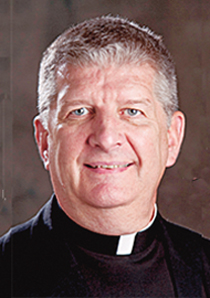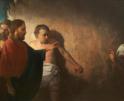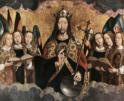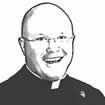
Faith
Viaticum -- it means "with you on the way" -- is really the last sacrament for a member of the faithful who is near death.

O'Grady
There is a new version of an important liturgical book that should be in each sacristy. It has the rather unwieldy title "Holy Communion and Worship of the Eucharistic Mystery outside of Mass," and its acronym HCWEMOM doesn't make for easier reference.
A previous version has been in use in the United States since 1976. This new version is a revised translation and renewed ordering of the contents.
The first chapter touches on topics addressed previously in this column -- the distribution of Holy Communion outside of Mass. This provides the celebrating community with two versions: a longer and shorter one. Each option consists of an introduction, a liturgy of the word, Holy Communion, and concluding rites. The leader of the assembly may be a deacon or a member of the assembly who has been formed to conduct these services. Bishops and priests may not use either of these; if one of them were present, then he would celebrate Mass.
The second chapter addresses the situation when one of the faithful is near death, and there is no bishop or priest available to celebrate the anointing of the sick and viaticum. This chapter is for the extraordinary minister, obviously previously trained and commissioned, to celebrate for the dying person, preferably with the presence of others, above all family members.
Viaticum -- it means "with you on the way" -- is really the last sacrament for a member of the faithful who is near death. To use an old phrase that is still very current is the "last rite." It is the reception of Holy Communion by the one nearing death. Sometimes, it is gently called "food for the journey."
That those on their journey to eternal life might be strengthened by the Eucharist, the church makes this "food" available by permitting, even urging, that extraordinary ministers be trained and commissioned to carry out this delicate ministry.
The full version of the rite consists of six parts: introductory rites, the Word of God, Profession of Baptismal Faith, Prayer for the Sick Person(s), and concluding rites. Not surprisingly, there is also an abbreviated version for emergency situations.
The ideal is the full version and the presence not only of the minister but also of family, friends, and, perhaps, staff if this is in a hospital or extended care facility. There is more than enough testimony readily available, likely from family, friends, and neighbors, about the comfort the dying receives at this moment from the reception of Holy Communion, but drawing strength from the presence and prayers of an even small community.
The third chapter deals with various forms of the worship of the Most Holy Eucharist. Included here are the form for exposition, adoration, and benediction of the Most Blessed Sacrament; form for a eucharistic procession -- becoming more common in parishes on the Solemnity of the Most Holy Body and Blood of Christ; and for eucharistic congresses -- diocesan, national, or international.
It would be the first two sections of this chapter that would be most useful for parishes and other communities, e.g., of religious, or associations of the Christ's faithful.
The matter of eucharistic congresses is really the responsibility of the diocesan bishop in his own diocese, the bishops' conference within its territory, and the Holy See for international eucharistic congresses.
There will be a diocesan Eucharistic Congress celebrated here in our archdiocese April 12-14, 2024. (See www.bostoneucharisticcongress.org)
This will serve as our lead-up in Boston to the 10th National Eucharistic Congress to be celebrated in Indianapolis July 17-21, 2024 (www.eucharisticrevival.org).
The 53rd International Eucharistic Congress will be celebrated September 8-15, 2024, in Quito, Ecuador: www.iec2024.ec/en.
When the new text arrives in parishes, the pastor and his liturgy team would be wise to review their own present practices and tweak them as needed.
It might be a good chance to gather the extraordinary ministers of the parish for a refresher course on their ministry with an emphasis on their ministry of viaticum.
Parishes, shrines, and other places of public worship might want to review the new text regarding their practices of "Benediction of the Blessed Sacrament," which sometimes serves as a shortened reference to the longer title "Exposition, Adoration, and Benediction." The new book contains both traditional and recently composed prayers and hymns for the various rites mentioned above.
"Holy Communion and Worship of the Eucharist Outside Mass" will be available from five publishers: Catholic Book Publishing, Liturgical Press, Liturgy Training Publications, Magnificat, and Midwest Theological Forum. Most will have editions available by Aug. 1, 2024. These may be used beginning on Sept. 14, 2024, and they must be used, that is replacing all previous versions, on Dec. 1, 2024.
Recent articles in the Faith & Family section
-
Our Lady of DeliveranceJaymie Stuart Wolfe
-
The 'month of the dead' brings its own strange refreshmentBishop Robert Reed
-
Make New Friends, But Keep the OldMaureen Crowley Heil
-
A royal truthScott Hahn
-
St. Cecilia and hope in sacred songRichard Clark


















